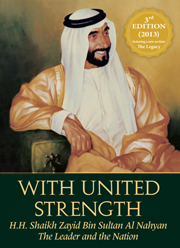Book contents
- Frontmatter
- Contents
- Note on Transliteration
- Abbreviations and Acronyms
- Foreword
- Introduction
- Part I The Heritage
- Part II The Transformation
- Part III The Union
- Chapter 7 Birth of a Nation
- Chapter 8 Sustaining the State
- Chapter 9 Defense and Preservation
- Chapter 10 With United Strength
- Part IV The Legacy
- Conclusion
- Notes
- Select Bibliography
- Index
- Plate Section
Chapter 8 - Sustaining the State
from Part III - The Union
Published online by Cambridge University Press: 05 September 2014
- Frontmatter
- Contents
- Note on Transliteration
- Abbreviations and Acronyms
- Foreword
- Introduction
- Part I The Heritage
- Part II The Transformation
- Part III The Union
- Chapter 7 Birth of a Nation
- Chapter 8 Sustaining the State
- Chapter 9 Defense and Preservation
- Chapter 10 With United Strength
- Part IV The Legacy
- Conclusion
- Notes
- Select Bibliography
- Index
- Plate Section
Summary
On a fine December day in 1971, a flag was added to the line of banners fluttering in the breeze outside the United Nations building in New York. It belonged to a new member-state, the United Arab Emirates. Red, green, white and black, the flag incorporated colors associated with all the emirates that comprised the new union, without being specific to any particular one. The emblem for the new state was chosen with equal care—on the one hand, the falcon, representing its heritage, and on the other, the dhows, symbolizing the maritime traditions of the emirates.
A year later, on December 2, 1972, the UAE celebrated one year of independence. The first National Day evoked intense excitement and tangible pride in the new state's achievements. Most houses in Abu Dhabi flew the national flag, while enthusiastic crowds came into the streets to watch the defense forces marching by. Military aircraft flew overhead. Following the parade, young men representing all the emirates of the union appeared, striding rank after rank before the President and Vice President, the Supreme Council, the Council of Ministers, members of the Federal National Council and an array of foreign dignitaries who had gathered for the occasion. Later in the day, the new national anthem was performed for the first time.
This impressive display of national confidence masked the fact that the new Federation had faced a number of difficulties from the outset. On the one hand, there were external dangers as powerful neighbors either maintained claims over its territory or remained in actual occupation.
- Type
- Chapter
- Information
- With United StrengthHH Sheikh Zayed Bin Sultan Al Nahyan: The Leader and the Nation, pp. 193 - 216Publisher: Emirates Center for Strategic Studies and ResearchPrint publication year: 2013



